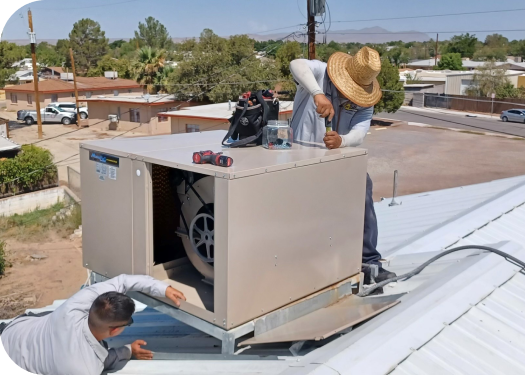The Significance of Heating And Cooling Setup: Secret Factors To Consider for a Comfy Indoor Setting
The installment of a HVAC system is a crucial component in accomplishing an energy-efficient and comfortable indoor environment. However, the process involves several nuanced considerations that exceed merely picking a device off the rack. Factors such as the viability of the system for details building requirements, correct sizing to prevent inadequacies, and the expertise of contractors for a top quality installment play essential functions. The fostering of advanced technologies can dramatically improve system performance. Yet, recognizing these intricacies is merely the start of making sure optimal interior comfort. What are the crucial aspects that dictate effective heating and cooling execution?
Selecting the Right System

When selecting a heating and cooling system, it is important to assess the capacity required to properly warmth or cool down the space without overworking the system, which can bring about raised wear and functional expenses. Consulting with a professional HVAC contractor can give beneficial understandings into picking a system that straightens with both the building design and the awaited use patterns of the structure.
Furthermore, thinking about the integration of clever technology can enhance system monitoring and tracking, offering better control and potential price savings. By meticulously analyzing these elements, one can make certain the choice of a HVAC system that not just meets prompt requirements yet likewise adds to long-lasting functional sustainability and resident convenience.
Comprehending Power Performance
Recognizing power performance is essential when considering a Heating and cooling setup, as it directly impacts both the environmental footprint and the operational costs of the system. The efficiency of a HVAC system is typically indicated by ratings such as SEER (Seasonal Power Performance Proportion) for air conditioners or AFUE (Yearly Fuel Usage Effectiveness) for furnaces.

Purchasing an energy-efficient HVAC system not just translates to cost financial savings but additionally contributes favorably to ecological conservation by decreasing greenhouse gas emissions. In addition, many territories offer rewards or rebates for the setup of high-efficiency systems, better improving their economic appeal.
When examining power efficiency, think about innovative features such as variable rate electric motors, smart thermostats, and zoning abilities. These technologies enhance the system's capability to readjust to varying demand, consequently maximizing energy use. It is vital to seek advice from heating and cooling experts that can provide understandings right into the most effective alternatives customized to details climate conditions and usage patterns, making sure optimal performance and comfort.
Significance of Appropriate Sizing

On the other hand, a small a/c system will certainly have a hard time to get to the preferred temperature level, especially throughout extreme climate condition. This can lead to continual operation, causing higher energy prices and potential getting too hot of system parts. Additionally, poor sizing can lead to inconsistent temperature level distribution, triggering particular areas of a building to be as well cool or also cozy.
To achieve the right sizing, a comprehensive load computation is vital. This involves analyzing various elements such as the building's square footage, insulation degrees, home window kinds, and local climate conditions. By precisely establishing the heating and cooling needs of an area, cooling and heating professionals can recommend systems that guarantee effective procedure, lowered power intake, and enhanced indoor comfort.

Ensuring Quality Installation
A smooth Heating and cooling installment is the foundation of a system's long life and performance. This specialist ought to have extensive expertise of diverse systems and be experienced at evaluating the details requirements of the structure.
Proper installment surpasses simple positioning of equipment. It entails precise calibration to make sure optimal air flow, reliable energy usage, and consistent temperature circulation. This includes precise ductwork installment, ensuring connections are safe and secure and leak-free, which is important for maintaining system effectiveness and interior air top quality.
Furthermore, the application of innovative analysis tools during setup can identify potential issues early, stopping pricey repairs and extending the life expectancy of the system. The specialist needs to additionally ensure that all components work and that the system adheres to neighborhood building ordinance and laws.
Regular Maintenance Practices
As soon as the structure for a high-performing a/c system is established through quality installment, the emphasis ought to shift to normal upkeep methods to ensure ongoing performance and dependability. Routine upkeep not only extends the life-span of the system however also boosts interior air quality, reduces power consumption, and prevents expensive repair work. Essential upkeep tasks include on a regular basis altering air filters, cleaning evaporator and condenser coils, and checking the system for leaks or clogs.
Air filters must be replaced or cleaned up every one to 3 months, depending on use and environmental aspects. This simple job can considerably boost air flow and system performance (Plumber in Brownwood TX). Cleansing the evaporator and condenser coils prevents dirt accumulation, which can hinder warm visit the website absorption and air conditioning ability. Furthermore, specialist service technicians ought to check the system annually, inspecting for cooling agent degrees, electrical connections, and general system efficiency.
Focus to ductwork is additionally crucial; sealing and cleaning up ducts on a regular basis protects against air loss and contamination. Implementing a maintenance schedule guarantees that minor problems are dealt with before they intensify, securing the system's operational stability. By adhering to these maintenance practices, property owners can enhance their heating and cooling system's performance and preserve a comfortable indoor environment year-round.
Conclusion
By choosing an ideal system tailored to details building demands, understanding energy performance, and guaranteeing proper sizing, ineffectiveness can be decreased. The involvement of proficient contractors assurances top quality installation, while the combination of innovative technologies improves system efficiency and surveillance.
Several types of Cooling and heating systems address are available, including split systems, crossbreed systems, duct-free systems, and packaged home heating and air systems, each with distinctive advantages and restrictions.
Comprehending power performance is important when thinking about a Cooling and heating installation, as it directly impacts both the environmental impact and the functional prices of the system. The performance of a HVAC system is usually suggested by scores such as SEER (Seasonal Energy Performance Proportion) for air conditioners or AFUE (Yearly Gas Application Performance) for furnaces (Plumber in Brownwood TX).Once the foundation for a high-performing link HVAC system is established through top quality installment, the emphasis must move to routine maintenance practices to make certain ongoing effectiveness and dependability. Additionally, professional service technicians need to check the system every year, inspecting for refrigerant degrees, electric connections, and overall system efficiency